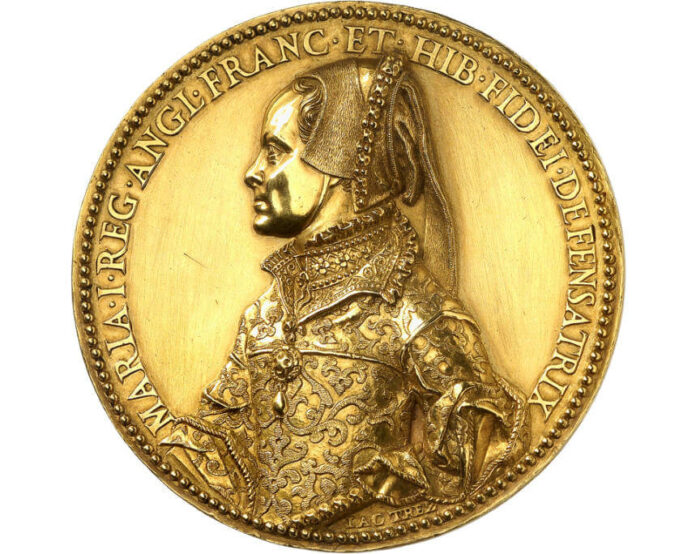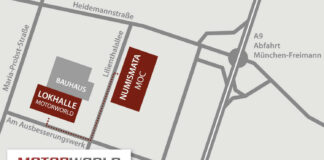The Top Results of Künker’s Spring Auction Sales 383 to 386
From 20 to 24 March 2023, the second part of Künker’s Spring Auction Sales took place. In three catalogs, the auction house presented a wealth of exciting individual pieces and collections from medieval and modern times. Additional lots from the modern period already went under the hammer on March 17 as part of the Wolf Collection. The total result of all auction catalogs – including ancient coins sold on 16 and 17 March – amounted to 15.4m euros. Compared to the total estimate of 9.1m euros, this is an increase of almost 70%.
In this review, we present the most expensive pieces of
- the Wolf Collection / modern period,
- the Schedel Collection with Salzburg coins and medals,
- the Bader Collection with coins and medals from the Enlightenment period,
- the Fleige Collection of bracteates,
- the two collections of Mainz coins and
- auction catalog 386.
The Wolf Collection / Modern Period
Roger Wolf was one of those collectors who were passionate about various topics. Besides ancient coins, he also collected pieces from those countries that he felt particularly connected to, namely Great Britain, Italy, Bavaria and Saxony. Applying what he had learned from collecting ancient issues, he paid attention to excellent quality, both regarding a coin’s condition and its engraving. Customers greatly appreciated that! Therefore, the total result was to exceed the estimate by more than 75%. The results of British and Bavarian issues were particularly impressive.
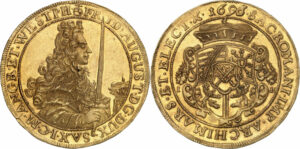
3rd Place
In third place there is a quadruple ducat by Augustus the Strong of Saxony, created in the year of the death of the Polish King John III Sobieski. At the time, Poland was an elective monarchy, and the Saxon Elector wanted to become the new king. His election was to cost Saxony 39 million reichstalers, most of which were given to Poles that were eligible to vote in the form of diplomatic gifts. Was this quadruple ducat among them? The piece graded MS63 by NGC jumped from an estimate of 50,000 euros to 65,000 euros.
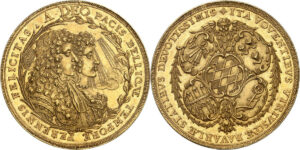
2nd Place
Just as much, namely 65,000 euros, were realized by the 5-ducat piece that had a significantly lower estimate of 15,000 euros. The coin was issued by the Bavarian territorial estates without a date on the occasion of the wedding of Max Emanuel and the Emperor’s daughter Maria Antonia. This made it the second most expensive modern coin of the Wolf Collection. The coin graded MS64 testifies to the change in alliance of the Bavarian duke. He wanted a royal crown for the Wittelsbach dynasty and sought to achieve this elevation of status in an alliance with Habsburg, thus no longer alongside France. He almost succeeded: Joseph Ferdinand, the only surviving son from his marriage with Maria Antonia, would have become the compromise candidate to inherit the throne of the Spanish Habsburgs, had he not died before the testator. Back at the side of France, Max Emanuel repeatedly tried to exchange “his” Bavaria for some royal crown. The Bavarians did not forgive him for this, and they also did not forgive him for the Sendling’s night of murder, a result of his failed policies.
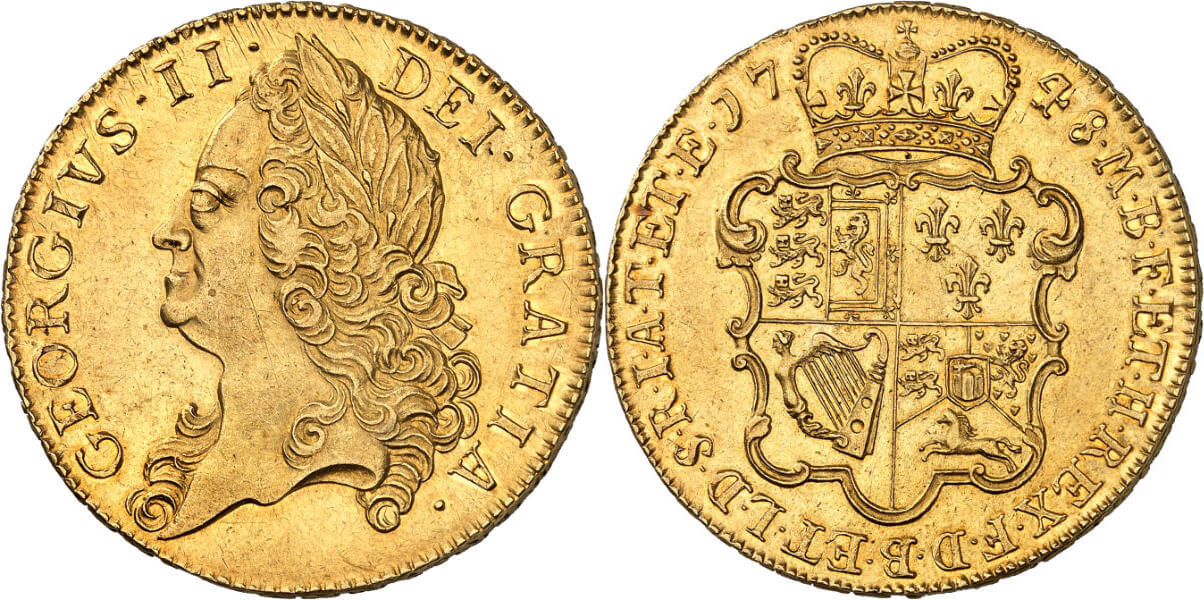
1st Place
70,000 euros compared to an estimate of 20,000 euros – that is the result of a magnificent 5-guinea piece with the portrait of George II, minted in 1748 in the 22nd year of the reign of the second Hanoverian on the British throne. This made the coin the most expensive modern issue of the Wolf Collection. The high result is no surprise. The heavy 5-guinea gold coins introduced by Charles II are particularly popular among collectors, especially when they are of such great quality. The piece was graded MS61. What was special about the new 5-guinea pieces at the time they were introduced was how hard it was to counterfeit them. Following the French model, they had an edge inscription, in our case it reads – translated into English – adornment and protection in the 22nd year of the reign. How this was done remained a state secret. All employees of the mint took an oath not to reveal the production methods to anyone.
Salzburg
Next is auction catalog 384, in which Künker offered an impressive collection of Salzburg coins and medals in collaboration with Mages GmbH on 20 March 2023. The Professor Dr. Franz Schedel Collection is probably the finest collection of Salzburg gold and silver multiple coins that has been auctioned since the Second World War. Thus, it is no surprise that the bids came from the entire world. The total result amounted to almost twice the original estimate. Although the very rare silver multiple issues achieved outstanding prices – most impressive was probably the double representative taler klippe (lot No. 2926) featuring the Salzburg city view that realized 57,500 euros at an estimate of 5,000 – the gold multiples dominate the list of top results. The gold coins, which were used as diplomatic gifts, illustrate how rich the salt trade had made the Archbishopric of Salzburg.
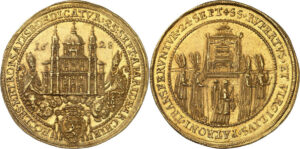
3rd Place
With a hammer price of 65,000 euros and an estimate of 20,000 euros, a tenfold ducat of 1628 came in third place. It was part of a series minted to have diplomatic gifts at hand for the occasion of the consecration of the Salzburg Cathedral. They were given to those present and sent to important people who could not attend the event. Therefore, the depiction illustrates what happened: The coin presents the new cathedral, held by the patron saints of the abbey, St. Rupert and St. Virgil. On the reverse, bishops carry the relics of the patron saints on their shoulders into the new cathedral.
By the way, two other pieces also fetched a result of 65,000 euros: No. 2854, a 15-fold ducat minted on the occasion of Guidobald von Thun und Hohenstein’s taking office, and No. 2894, a klippe of 10 ducats, issued as a diplomatic gift at the assumption of office of Max Gandolph von Küenburg; since in both cases the estimate was much closer to their hammer prices, we assigned them 4th and 5th place.
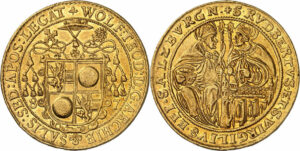
2nd Place
When Paris of Lodron celebrated a feast on the occasion of the consecration of the Salzburg Cathedral, he was the beneficiary of his predecessor Wolf Dietrich von Raitenau. The latter had initiated the rebuilding of the Salzburg Cathedral after the great fire of 1598. However, Wolf Dietrich was removed from office while the construction was still ongoing. After all, he was a typical representative of the church – a man of the kind that was resented by both important groups of the time, the Catholic nobility and Reformers. A nephew of the influential Cardinal Charles Borromeo, he had already been appointed Archbishop of Salzburg at the age of 28 years, i.e. before canonical age. The 10-fold ducat of 1587, offered by Künker as lot No. 2671, was probably minted on the occasion of him taking this ecclesiastical office. It had been estimated at 40,000 and realized a hammer price of 70,000, making it second place in our top five list.
Today, Wolf Dietrich is known for the fact that – despite the explicit order of the Council of Trent – he lived in a marriage-like union with Salome Alt. This, however, was not the reason for him being removed, it was a dispute with the Duke of Bavaria about the revenues from the salt trade.

1st Place
220,000 euros at an estimate of 75,000 euros – that is the result of the most expensive piece in the entire Schedel Collection and the second-most expensive piece in the auction sale. It is a highly rare 25-fold ducat, also issued for the consecration of the Salzburg Cathedral. In 1687, Johann Ernst von Thun und Hohenstein came to office. He went down in history as the “founder”. Many baroque churches and monasteries around Salzburg owe their appearance to him. The fact how rich Salzburg was at the time is also illustrated by the large number of coin series and gold multiples that were minted for his investiture. The Schedel Collection alone contains gold coins of four, five, six, eight, ten and twenty-five ducats!
Bader Coll.
21 March 2023 was dedicated to auction 385 and thus to the Bader Collection. Its creator had come up with a highly complex concept for his collection that dealt with the question of how the Enlightened military dictatorship of Napoleon was able to develop from absolutism. Frank Bader studied the appreciation of the Enlightenment of various monarchs through the depictions on their coins and medals. Thus, his collection became an overarching ensemble that went beyond any national approach. Therefore, the Bader Collection had something for everyone, including numerous surprises.

3rd Place
One of them was a 10-ducat medal issued for the coronation of Maria Theresa as Queen of Bohemia on 12 May 1743. She was crowned in Prague, which may be one of the reasons for the coin’s high result. Pieces that are linked to Czech history are booming. The very rare piece was estimated at 10,000 and sold at 44,000. This made it 3rd in our top list of the Bader Collection.
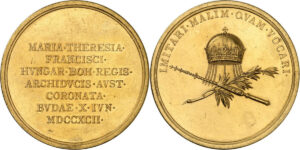
2nd Place
The second-most expensive lot of the Bader Collection was also issued for Maria Theresa’s coronation. However, this 20-fold ducat is not about the famous ruler of that name. It is dedicated to her namesake, the second wife of Francis II, who succeeded his brother Leopold II as emperor after his death on 1 March 1792. Alongside his wife, he was crowned Hungarian king on 10 June 1792. This event is commemorated by a medal, which changed hands at 46,000 euros at Künker while the estimate had been 10,000 euros. By the way, Maria Theresa was not crowned in the proper sense of the word. A copper engraving illustrates that the Holy Crown of Hungary merely touched her shoulder as a sign that she had to bear the burden of rule together with her husband.
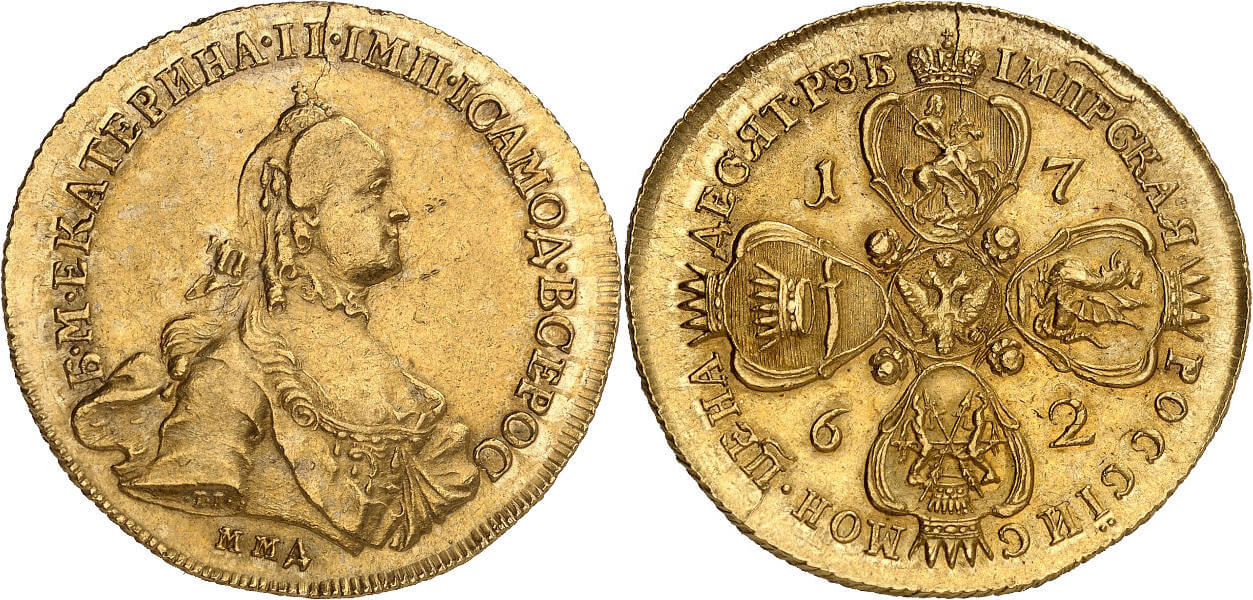
1st Place
75,000 euros, exactly triple its estimate of 25,000 euros was the result of the most-expensive piece of the Bader Collection, a 10-fold rouble of Catherine II of 1762. The collector probably chose this year very wisely. It was not only the year of her ascending the throne but also the year in which she invited Diderot to Russia, to prepare a Russian translation of the Encyclopédie. After all, Catherine was one of the greatest PR geniuses of early modern times. She gained appreciation abroad by using Russian funds to generously support leading French Enlighteners – who were the most important opinion makers in Europe at the time. In return, the intellectuals spread her fame as an enlightened, “great” ruler. The fact that the praise of one Voltaire contrasted Russian reality was already ridiculed by Catherine’s Russian contemporaries.
The Most Expensive Coins from Auction 386
Several special collections were sold at once in auction 386, which took place from 22 to 24 March 2023 in Osnabrück. To list the top results of all these collections would go far beyond the scope of this review. Therefore, we limit ourselves to the most expensive piece each of the Fleige Collection of bracteates, and the two Mainz collections of. Prof. Alois Memmesheimer and Heinz Beaury, before we present the five most expensive coins of auction sale 386 as a whole.
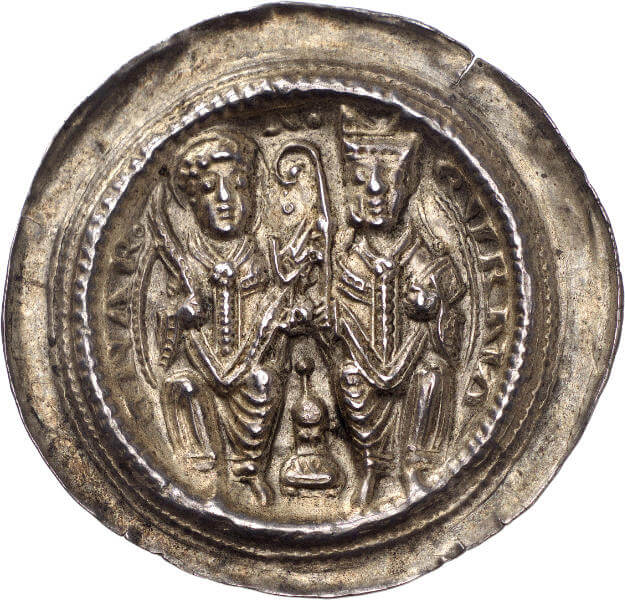
The most expensive piece of the impressive collection of bracteates of Peter Fleige cost “only” 13,000 euros (estimate: 4,000 euros), a high price, but also one that illustrates that most bracteates can still be bought for comparatively little money today. The piece stands out both due to an excellent provenance dating back to 1885, its artistic design, its great rarity and, above all, its historical importance. It takes us back to a time when Frederick Barbarossa appointed his ally Otto of Wittelsbach as Duke of Bavaria in 1180, depriving Henry the Lion of his office. The younger brother of Otto benefited from this alliance. Conrad of Wittelsbach had taken the wrong (the papal) side during the Western Schism and had thus been forced out of his diocese by the emperor. But when the Emperor’s preferred bishop died in 1183, Frederick Barbarossa gave back the Mainz bishopric to Conrad. St. Martin, who is featured on the coin, was the patron saint of the Mainz Cathedral. Frederick thus rewarded this Wittelsbach ruler with the most important office an emperor could bestow: the Archbishop of Mainz was also the Archchancellor of Germania and chairman of the Electoral College, the body that elected the emperor.

This bracteate was a little foretaste of the two extensive collections of coins from the Mainz Archdiocese offered by Künker in Auction 386. The double ducat of Bishop Anselm Franz von Ingelheim is from the Alois Memmesheimer Collection The extremely fine piece minted in 1680 jumped from an estimate of 15,000 to a hammer price of 28,000 euros.
This brings us to the end of this review and the five most expensive coins and medals from auction 386.

5th Place
In 5th place, with an estimate of 50,000 euros and a hammer price of 70,000 euros, we have a medal featuring the portrait of the Russian Tsarina Elizabeth I, created by the renowned Geneva medalist Dassier. It commemorates the foundation of the Moscow State University and shows a personification of Russia in front of a Moscow city view. The extremely rare piece has probably an interesting pedigree: a specimen of the same weight was auctioned in February 1934 by Felix Schlessinger in Berlin. Unfortunately, it cannot be proven beyond doubt that the two pieces are the same, as depictions were expensive at the time and Felix Schlessinger opted to go without it.

4th Place
In fourth place we have a coin from Prague. For several years, coins issued by this mint have been realizing record prices. It is a quintuple ducat that Ferdinand II had minted in 1636. It depicts the armored ruler with scepter and imperial eagle on the obverse, on the reverse the Habsburg double eagle. Although the piece is “only” of very fine quality and has an incised face value “V”, it jumped from an estimate of 50,000 euros to an impressive result of 80,000 euros.
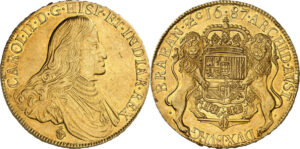
3rd Place
We are still with the Habsburgs, but change the branch. A ducaton d’or minted in Brussels on behalf of Charles II of Spain tripled its estimate of 30,000 euros; thus it achieved a result of 95,000 euros and became the third most expensive piece of auction 386.
Charles II was the last Habsburg on the Spanish throne. Since he died childless – and because the son of the Bavarian duke Max Emanual that he had appointed as his successor had also died before him – his death triggered the War of the Spanish Succession.
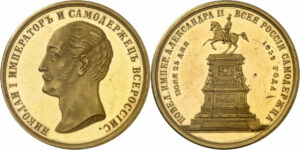
2nd Place
120,000 euros compared to an estimate of 25,000 euros, that was the hammer price of an extremely rare gold medal with the portrait of Alexander II, making the piece the second most expensive issue of auction 386 and the third most expensive piece of Künker’s entire auction week. The medal commemorates the erection of the monument for Nicholas I of Russia. The construction of this horseman statue of 6 meters that rests only on the horse’s hind legs was considered a technical marvel at the time.
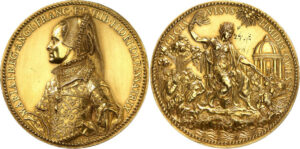
1st Place
Let us present the most expensive piece of the sale. At 525,000 euros, the gold medal created for the wedding of Mary Tudor and Philip II of Spain, remained below its estimate but still became one of, if not the most expensive medal ever sold at a German auction sale. What is special about the piece is the great rarity and its historical significance. In this article you will learn more about the medal. It can be assumed that one of the highest monarchs of Catholic Europe received the medal as a gift.
It you think about making a consignment yourself, please contact Künker, Nobbenburger Straße 4a, 49076 Osnabrück; Tel: +49 541 / 962020; fax: +49 541 / 9620222; or via e-mail.
You can find the auction results online.




